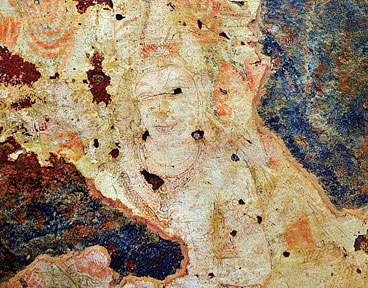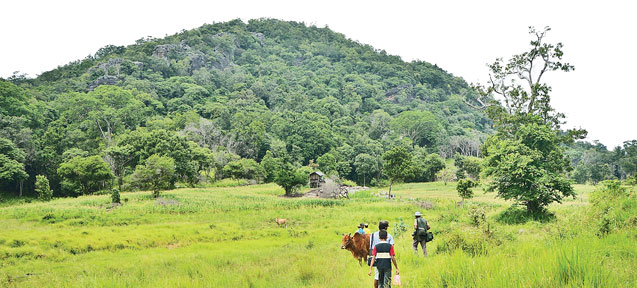|
Kotiyagala
Repository of ancient cave paintings :
|

The Mailla cave with its reclining Buddha statue which was
vandalized by treasure hunters |
We learnt that the illegal logging and stripping of the ground mercilessly by
illicit loggers without any thought on the impact it had on the environment in
the Kotiyagala forest which acts as a buffer zone for the Yala National Park had
dire effects on wildlife. Kotiyagala is a vital part of the important jungle
corridor that connects the Lahugala National Park to the Yala National Park.
Story and pictures
by Mahil Wijesinghe
The final destination of our Kumana trip was the Mailla rock cave in Kotiyagala.
Bidding adieu to the Magul Maha Vihara at dusk on the third day we set off
toward Kotiyagala. Taking a left turn from the Kodayana junction, we found
ourselves on the Moneragala-Athimale road, which fell through a quiet rural
setting with lush vegetation.
Darkness engulfed us at Athimale and we had to get help from some villagers to
find the way to Wattarama temple at Athimale where we planned to spend a night
because it is the closest place to reach Kotiyagala. Although I had visited the
Wattarama temple a decade ago, it was impossible for me to find the way now due
to the darkness and many changes.
Compound
However, we managed to reach the temple and parked our jeep in the temple
compound. Chintaka and I decided to meet the chief priest first and asked our
group to follow us later. After a pleasant conversation with the priest and
expressing our motive, the priest allowed us to spend the night at the temple
and we were treated with a nice cup of tea and dinner cooked by a few devotees
at the temple. We met some devotees who are on a pilgrimage to Kebilitta Devale
staying in this temple.
|

The extraordinary paintings of the Mailla cave |
We soon understood that the Wattarama temple has become popular pilgrimage site,
courtesy of the 30 kilometre Kotiyagala route to Kebilitta Devale, which cuts
across Wattarama, making the temple a very welcome transit point for weary
devotees to rest before continuing with their journey.
It was an exciting and fresh morning though the impending rain cast a dark
shadow over the sky. After a good night’s sleep followed by the heartwarming
hospitality by the temple priests, we were ready for our final destination to
visit the Mailla cave in Kotiyagala.
Inaccessible
A quick but filling breakfast of ‘Roti’ cooked by Susantha was taken and a good
number of water bottles were packed into the jeep. We were ready to go. Since
there was no one in the temple to join us, we decided to ask a villager to guide
us while we proceeded through chena cultivations off the roads. The hunting
sounds of peacocks juxtaposed with the dawn chorus of the laughing thrush filled
the morning air as we followed the 10 kilometre long, narrow and nearly
inaccessible jungle track from Kotiyagala to the Mailla cave that can only be
negotiated by a 4WD vehicle.
The muddy streams and rocky protrusions made the journey arduous, compelling us
to make frequent stops. Our plan was to drive as deep as possible into the
jungle in order to reduce the distance we had to walk. The tracks were deserted
and there was no one to ask directions from. Wandering around we finally came
across a young boy from Kotiyagala, returning from his Chena, who offered to
accompany us to the Mailla cave.
We drove along the narrow track crossing muddy streams amidst maize (corn)
cultivations and reached the border of a maize chena land. We left the jeep
under the shade of a big tree. In 1975 the road to Mailla via Kotiyagala cut
across heavily grown jungle, with a significant wildlife population. Over the
past few decades, chena cultivations and deforestation has completely denuded
the thick forest, exposing the Mailla cave which now lies in the middle of an
isolated pocket of jungle. Access to the cave is by foot and it is around a five
kilometre long trek, across a sea of Illuck grass, shrub jungle, rock boulders
and muddy streams. Historical records indicate that the cave shrine of Mailla
grew into the monastery between 4th and 5th century AC and it was embellished
with all the features of an important Buddhist shrine.
Sigiriya
 The most striking feature of this forgotten place is the rich paintings on the
ceiling of the cave. These partially destroyed paintings are drawn in faded red
and yellow applying many layers on the rock surface. They are believed to be
some of the oldest paintings in the country. They are as old as Sigiriya and
judging by their remains, almost as beautiful. The paintings depict elephants,
deer and birds. Then there are female figures similar to the Apsaras at Sigiriya. The most striking feature of this forgotten place is the rich paintings on the
ceiling of the cave. These partially destroyed paintings are drawn in faded red
and yellow applying many layers on the rock surface. They are believed to be
some of the oldest paintings in the country. They are as old as Sigiriya and
judging by their remains, almost as beautiful. The paintings depict elephants,
deer and birds. Then there are female figures similar to the Apsaras at Sigiriya.
Having journeyed into the heart of the jungle of Kotiyagala which lies in the
drought –affected Moneragala district, we were appalled by the willful
destruction which had occurred in the pristine jungles as a result of burning
for chena cultivations for decades. The whole jungle had burnt except the
summits of the hills and now Illuck grass had grown everywhere under a few trees
remaining here and there to remind us of the lost forest.
We learned that businessmen from far away have acquired vast stretches of lands
here and engage in massive maize cultivations deploying nearby villagers who
live around Kotiyagala. Some villagers of Kotiyagala also engage in small scale
cultivations such as pumpkins, water melons and Kurakkans in and around stripped
jungles.
When we ventured deep into the jungle we saw vast stretches of land used for
maize cultivation as far as the eye can see while some villagers also engage in
dairy farming looking after herds of buffalos and cows in the middle of the
jungle around a “wadiya” (small hut thatched with Illuck grass).
Loggers
We learnt that the illegal logging and stripping of the ground mercilessly by
illicit loggers without any thought on the impact it had on the environment in
the Kotiyagala forest which acts as a buffer zone for the Yala National Park had
dire effects on wildlife. Kotiyagala is a vital part of the important jungle
corridor that connects the Lahugala National Park to the Yala National Park. The
jungle corridor enables species to migrate from one national park to another and
this link is particularly important for the breeding of species. The
deforestation of this area could mean the permanent disruption of these links,
which has an adverse effect on animal life in the parks.
Burning jungles is also another way of destroying priceless artifacts such as
paintings and clay images in the cave shrines in the jungles. The best example
is the Mailla cave we visited which is still remains intact, although its
reclining Buddha statue has been destroyed in several places by treasure
hunters. Despite the destruction, the Mailla Buddha statue is in better
condition today due to a Good Samaritan, who had taken it upon himself to repair
and retouch the vandalized statue.
Treasure
|

The landscape of Kotiyagala: once a heavily grown jungle
today confined to the isolated pocket of jungle across the
sea of Illuck grass and maize cultivation. |
The armed groups who mostly roam in the forests, we learnt, were a group of
treasure hunters who were also carrying out poaching, illicit timber felling and
the odd Ganja plantation. They could all be carried out much closer to the
villages.
There are hundreds if not thousands of ruins still left unaccounted for buried
deep within the forests. These are the perfect targets of the few organized
groups of treasure hunters. Politicians and businessmen seem to have caused the
most damage here. At Kotiyagala, we were saddened to see massive deforestation
and vandalizing of our priceless heritage of ancient Buddhist monuments in
caves.
It was late afternoon and so we had bid farewell to Kotiyagala and its lost
heritage and greenery, which we will never see again in any better shape. We
returned to the Wattarama temple in late afternoon, had a light lunch and a nap
for about 30 minutes in the spacious Dhamma Salawa (Sermon Hall). Ending our
adventurous four day trip, we set off on our return trip to Colombo. By the time
we reached Ratnapura it was midnight and Chintaka and others proceeded to
Colombo after dropping me at my home in the City of Gems. |

